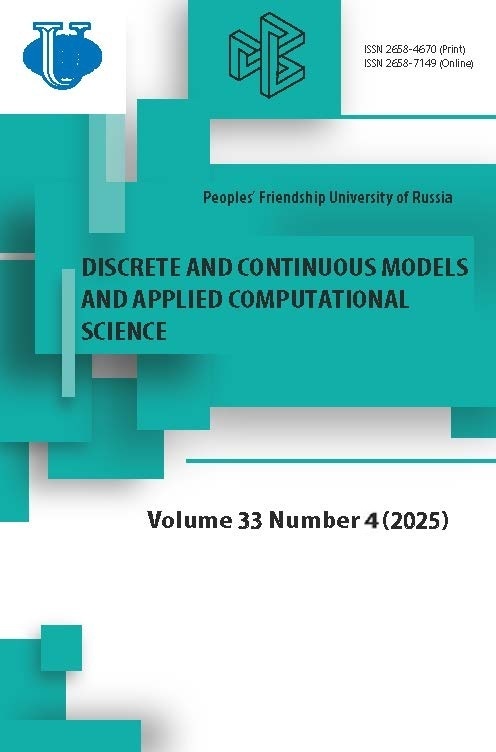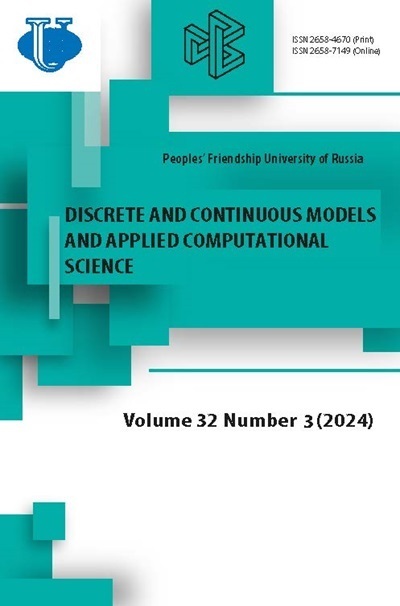Symbolic-numeric approach for the investigation of kinetic models
- Authors: Demidova E.A.1, Belicheva D.M.1, Shutenko V.M.1, Korolkova A.V.1, Kulyabov D.S.1,2
-
Affiliations:
- RUDN University
- Joint Institute for Nuclear Research
- Issue: Vol 32, No 3 (2024)
- Pages: 306-318
- Section: Modeling and Simulation
- URL: https://journals.rudn.ru/miph/article/view/43411
- DOI: https://doi.org/10.22363/2658-4670-2024-32-3-306-318
- EDN: https://elibrary.ru/FEMNAB
- ID: 43411
Cite item
Full Text
Abstract
Our group has been investigating kinetic models for quite a long time. The structure of classical kinetic models is described by rather simple assumptions about the interaction of the entities under study. Also, the construction of kinetic equations (both stochastic and deterministic) is based on simple sequential steps. However, in each step, the researcher must manipulate a large number of elements. And once the differential equations are obtained, the problem of solving or investigating them arises. The use of symbolic-numeric approach methodology is naturally directed. When the input is an information model of the system under study, represented in some diagrammatic form. And as a result, we obtain systems of differential equations (preferably, in all possible variants). Then, as part of this process, we can investigate the resulting equations (by a variety of methods). We have previously taken several steps in this direction, but we found the results somewhat unsatisfactory. At the moment we have settled on the package Catalyst.jl, which belongs to the Julia language ecosystem. The authors of the package declare its relevance to the field of chemical kinetics. Whether it is possible to study more complex systems with this package, we cannot say. Therefore, we decided to investigate the possibility of using this package for our models to begin with standard problems of chemical kinetics. As a result, we can summarize that this package seems to us to be the best solution for the symbolic-numerical study of chemical kinetics problems.
Full Text
1. Introduction The chemical kinetics equations (chemical reaction networks, CRN) are a simplified version of the stochastic kinetic equations. In the works of C. W. Gardiner [1] and N. G. Van Kampen [2] the chemical kinetics equations are derived from the more general stochastic kinetic equations. Model representation in the form of CRN is mostly used in biochemistry, theoretical chemistry and biology. Such models are based on a combination of a set of substances, which defines the state of the system, and a set of reaction events, which describe reaction rates and rules for changing the state of the system as they occur. This structure makes it easier to understand and analyze the model. Each reaction includes reagents (initial substances) and products (substances that are formed as a result of a reaction), which are written as concentrations of objects in the extended sense. For instance, in the work [3] A. Lotka derived a system of stochastic equations from hypothetical chemical reaction. The same model was independently arrived at by V. Volterra [4]. This model describes predator-prey species interaction. The equations of chemical kinetics are constructed according to rather primitive (but also somewhat cumbersome) rules. It seems justified to use the analytic-numerical approach for these tasks. This paper provides an overview of the main functions of the Catalyst.jl library [5, 6] for the programming language Julia [7, 8], which provides a toolkit for symbolic-numerical exploration of chemical kinetics models [9]. The Julia programming language is widely used in biology, providing a large number of tools [10, 11]. Due to Julia’s support for the metaprogramming paradigm, this language is well-suited for implementing custom domain-specific languages. For example, it is possible to implement a computer algebra subsystem integrated into the language [12]. 1. Paper structure The section 2 briefly provides an overview of the basic principles of chemical kinetics. The section 3 provides brief information about the Catalyst.jl package. The sections 4 and 5 consider examples of constructing and solving one-dimensional and multidimensional models, respectively. The models are presented in both deterministic and stochastic forms. 2. Chemical kinetics equations Representation of kinetics equations in the form of chemical reactions is widely used in modeling. We will briefly examine the structure of equations of this type. Consider mixtures of chemical substancesAbout the authors
Ekaterina A. Demidova
RUDN University
Email: 1032216451@rudn.ru
ORCID iD: 0009-0005-2255-4025
Student of Department of Probability Theory and Cyber Security
6 Miklukho-Maklaya St, Moscow, 117198, Russian FederationDaria M. Belicheva
RUDN University
Email: 1032216453@rudn.ru
ORCID iD: 0009-0007-0072-0453
Student of Department of Probability Theory and Cyber Security
6 Miklukho-Maklaya St, Moscow, 117198, Russian FederationVictoria M. Shutenko
RUDN University
Email: shutenkovika@yandex.ru
ORCID iD: 0000-0003-3922-4805
Student of Department of Probability Theory and Cyber Security
6 Miklukho-Maklaya St, Moscow, 117198, Russian FederationAnna V. Korolkova
RUDN University
Email: korolkova-av@rudn.ru
ORCID iD: 0000-0001-7141-7610
Scopus Author ID: 36968057600
ResearcherId: I-3191-2013
Docent, Candidate of Sciences in Physics and Mathematics, Associate Professor of Department of Probability Theory and Cyber Security
6 Miklukho-Maklaya St, Moscow, 117198, Russian FederationDmitry S. Kulyabov
RUDN University; Joint Institute for Nuclear Research
Author for correspondence.
Email: kulyabov-ds@rudn.ru
ORCID iD: 0000-0002-0877-7063
Scopus Author ID: 35194130800
ResearcherId: I-3183-2013
Professor, Doctor of Sciences in Physics and Mathematics, Professor of Department of Probability Theory and Cyber Security of RUDN University; Senior Researcher of Laboratory of Information Technologies, Joint Institute for Nuclear Research
6 Miklukho-Maklaya St, Moscow, 117198, Russian Federation; 6 Joliot-Curie St, Dubna, 141980, Russian FederationReferences
- Gardiner, C. W. Handbook of Stochastic Methods: for Physics, Chemistry and the Natural Sciences (Springer Series in Synergetics, 1985).
- Van Kampen, N. G. Stochastic Processes in Physics and Chemistry (Elsevier Science, 2011).
- Lotka, A. J. Elements of Physical Biology 435 pp. (Williams and Wilkins Company, Baltimore, 1925).
- Volterra, V. Leçons sur la Théorie mathématique de la lutte pour la vie French (Gauthiers-Villars, Paris, 1931).
- Loman, T. E., Ma, Y., Ilin, V., Gowda, S., Korsbo, N., Yewale, N., Rackauckas, C. & Isaacson, S. A. Catalyst: Fast Biochemical Modeling with Julia Aug. 2022. doi: 10.1101/2022.07.30.502135. bioRxiv: 2022.07.30.502135.
- Loman, T. E., Ma, Y., Ilin, V., Gowda, S., Korsbo, N., Yewale, N., Rackauckas, C. & Isaacson, S. A. Catalyst: Fast and flexible modeling of reaction networks. PLOS Computational Biology 19 (ed Ouzounis, C. A.) e1011530.1-19. doi: 10.1371/journal.pcbi.1011530 (Oct. 2023).
- Bezanson, J., Karpinski, S., Shah, V. B. & Edelman, A. Julia: A Fast Dynamic Language for Technical Computing, 1-27. arXiv: 1209.5145 (2012).
- Bezanson, J., Edelman, A., Karpinski, S. & Shah, V. B. Julia: A fresh approach to numerical computing. SIAM Review 59, 65-98. doi: 10.1137/141000671. arXiv: 1411.1607 (Jan. 2017).
- Fedorov, A. V., Masolova, A. O., Korolkova, A. V. & Kulyabov, D. S. Implementation of an analyticalnumerical approach to stochastization of one-step processes in the Julia programming language in Workshop on information technology and scientific computing in the framework of the XI International Conference Information and Telecommunication Technologies and Mathematical Modeling of HighTech Systems (ITTMM-2021) (eds Kulyabov, D. S., Samouylov, K. E. & Sevastianov, L. A.) 2946 (Moscow, Apr. 2021), 92-104.
- Roesch, E., Greener, J. G., MacLean, A. L., Nassar, H., Rackauckas, C., Holy, T. E. & Stumpf, M. P. H. Julia for Biologists 2021. doi: 10.48550/ARXIV.2109.09973. arXiv: 2109.09973.
- Pal, S., Bhattacharya, M., Dash, S., Lee, S.-S. & Chakraborty, C. A next-generation dynamic programming language Julia: Its features and applications in biological science. Journal of Advanced Research, 1-12. doi: 10.1016/j.jare.2023.11.015 (Nov. 21, 2023).
- Kulyabov, D. S. & Korol’kova, A. V. Computer Algebra in JULIA. Programming and Computer Software 47, 133-138. doi: 10.1134/S0361768821020079. arXiv: 2108.12301 (Mar. 2021).
- Laidler, K. J. Chemical Kinetics 3rd ed. 531 pp. (Prentice Hall, Inc., Jan. 17, 1987).
- Korolkova, A. V. & Kulyabov, D. S. One-step Stochastization Methods for Open Systems. EPJ Web of Conferences 226 (eds Adam, G., Buša, J. & Hnatič, M.) 02014.1-4. doi: 10.1051/epjconf/202022602014 (Jan. 2020).
- Doi, M. Stochastic theory of diffusion-controlled reaction. Journal of Physics A: Mathematical and General 9, 1479-1495. doi: 10.1088/0305-4470/9/9/009 (1976).
- Schlögl, F. Chemical reaction models for non-equilibrium phase transitions. Zeitschrift für Physik 253, 147-161. doi: 10.1007/BF01379769 (1972).
- Hnatič, M., Eferina, E. G., Korolkova, A. V., Kulyabov, D. S. & Sevastyanov, L. A. Operator Approach to the Master Equation for the One-Step Process. EPJ Web of Conferences 108 (eds Adam, G., Buša, J. & Hnatič, M.) 58-59. doi: 10.1051/epjconf/201610802027. arXiv: 1603.02205 (2016).
- Korolkova, A. V., Eferina, E. G., Laneev, E. B., Gudkova, I. A., Sevastianov, L. A. & Kulyabov, D. S. Stochastization Of One-Step Processes In The Occupations Number Representation in Proceedings 30th European Conference on Modelling and Simulation (ECMS, Regensburg, Germany, June 2016), 698- 704. doi: 10.7148/2016-0698.
- Rackauckas, C. & Nie, Q. DifferentialEquations.jl A Performant and Feature-Rich Ecosystem for Solving Differential Equations in Julia. Journal of Open Research Software 5. doi: 10.5334/jors.151 (2017).
- Bazykin, A. D. Nonlinear Dynamics of Interacting Populations ed. by Khibnik, A. I. Ed. by Krauskopf, B. doi: 10.1142/2284 (World Scientific, Singapore, May 1998).
Supplementary files















